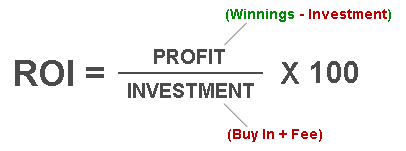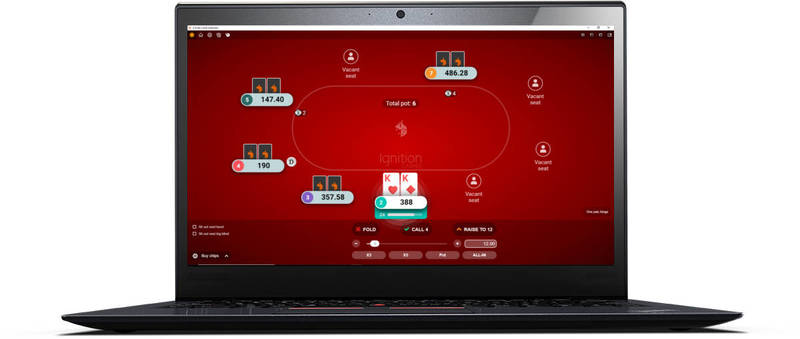Sit and Go Poker ROI
SNG Player? Find out which poker rooms have the softest sit and go games in 2026.

I'm sure you've all bumped in to the term "ROI" before, and you're probably aware that it stands for Return On Investment. It sounds like one of those terms you'll hear thrown around inside a business meeting along with the word "synergy".
So what's ROI got to to with poker tournaments exactly? Well, allow me to explain in this guide to everything you need to know about ROI in poker.
What is SnG ROI?
ROI is your average profit from sit and go’s. Your ROI is shown as a percentage of your SNG buy-in + entry fee.
So for example, if you have a ROI of 10% in $10+$1 SNGs, you are making an average profit of $1.10 from each of these games you play.
Note: ROI does take in to account the money paid in tournament fees.
If you're a cash game player, check out my poker winrates article for info on the "ROI" of cash games.
How to work out your poker ROI.
You work out your return on investment in poker just as you would work out ROI in any other field.
Divide your profit by your total investment, then multiply that number by 100 to get the ROI percentage.

Equations always look more complicated than they really are.
For example, if you entered a 9-seater $10+$1 SNG at PokerStars and won the first prize of $45, your ROI for that one game would be:
- Profit = $45 - $11 = $34
- Investment = $11
- ROI = ($34 / $11) x 100 = 309%
This is obviously an extremely high ROI, and it’s far from sustainable (in reality you would struggle to maintain an average ROI of 25%). However, this is just an example to show how easy it is to work out ROI.
ROI is more commonly used when looking at your winnings over a much larger sample size.
What’s a good sit and go ROI?
It’s very hard to work out accurate (and attainable) ROIs. However, from my experience these percentages should give you a rough idea of what an impressive ROI would look like at each level of 9s SNGs:
| Level | ROI |
|---|---|
| less than $6 | 20% |
| $6 / $11 | 15% |
| $22 | 10% |
| $33 | 7% |
| $55 | 5% |
| $109 | 4% |
| $215 | 3% |
These numbers are the upper limit of the sort of ROI you could hope for in SNG tournaments, so don’t be at all disappointed if your ROI is lower.
In all honesty, you should be proud of any ROI above 0%.
How can you find out your SNG ROI?
There are 3 ways:
- Sharkscope - the simplest method, but not super accurate.
- Tracking software (e.g. HEM or PT) - the most accurate method, but you have to buy the software first.
- Notepad - if all else fails.
1) Sharkscope.

Sharkscope is a website that tracks the results of online poker tournaments. Just search for your username and it should (hopefully) give you an indication of your average ROI from the tournaments you have played online.
The stats are limited and they’re not 100% accurate, but it’s a very quick and easy way to get an idea of your overall ROI. It's also free, but only for up to 5 searches a day. If you want to perform more searches you have to pay to subscribe.
2) Tracking software.
Using tracking software like Holdem Manager or Poker Tracker is the most accurate way of recording your results and finding your ROI across the different levels of SNGs you have played.
This poker software costs money to buy, but they offer far more features than just the ability to record your results and calculate ROI. If you’re serious about playing SNGs and trying to win money, I'd highly recommend you grab yourself a copy of Holdem Manager.
3) Notepad.
Nothing wrong with tracking results the old fashioned way!
It takes a little more effort than the other two options, but if you keep note of the number of games you've played and your winnings then you can easily work out your ROI for yourself.
SNG ROI and hourly rate.
Hourly rate is the amount of money you are making from SNGs on average per hour.
Knowing your ROI per game is nice, but for many the hourly rate is a more useful statistic. So how do you figure out your hourly rate?
Simple: Find out how many SNGs you play on average in one hour, then multiply that number by your ROI.
Quick example of ROI and hourly rate.
Let’s say you have an ROI of 6% in $11 SNGs. This means you are winning an average of $0.66 per game.
Due to the fact that you multi-table frequently, you have worked out that you play an average of 8 SNGs an hour. Therefore:
- Hourly rate = ROI x SNGs per hour
- Hourly rate = $0.66 x 8
- Hourly rate = $5.28
So with your current ROI, you’re earning $5.28 an hour from multi-tabling SNGs. Not bad, but probably not worth quitting your day job over.
With this figure you could go on to work out how much you might earn on average in a day, a week, a month or even a year - which is handy. Check out my article on how much can you win from online poker? for more calculations on this sort of stuff.
Average sit and go duration.
| SNG | Duration |
|---|---|
| 9s | 70 mins |
| 18s | 95 mins |
| 27s | 110 mins |
| 45s | 125 mins |
These are very rough figures, and they can obviously vary from one poker site to the next (depending on tournament structure). Nonetheless, hopefully you can use these numbers to give you a rough idea of how many SNGs you might be able to squeeze in per hour on average.
If you have tracking software like Holdem Manager on the other hand, it will work out your hourly rate for you.
How many SNGs do you have to play to get a reliable ROI?
1,000.
If you want to get a rough (there’s that word again) idea of what your ROI might be for sit and go’s, you want to have at least 1,000 SNGs under your belt.
Even then, your ROI from having played this many SNG tournaments isn’t going to be set in stone either, as variance can have a significant effect on your ROI over this sample size. However, 1,000 SNGs is widely regarded as the number you want to aim for before drawing any conclusions from or putting any stock in to your ROI.
To get a good idea of what your real ROI is though, you want to aim for 5,000 SNGs.
ROI reliability based on number of games played.
- 500 - a very rough idea.
- 1,000 - a rough idea.
- 5,000 - a good idea.
To prove this, watch this video on ROI simulations on Youtube, or download and try the poker ROI simulator out for yourself. Here's a link to the original ROI simulator thread at 2+2 (it also has a quick guide to using the program).
For even more detailed information on the reliability of your ROI based on number of games played, feel free to wade through this article at 2+2 on SNG Poker ROI confidence intervals.
Factors that affect your ROI and hourly rate.
Your ability. The better you are at play SNGs, the higher your ROI will be from each game. This is where Texas Hold'em strategy comes in useful.
SNG level. The higher up the stakes you go, the better the players become. This will reduce your ROI (as shown above in the “what’s a good ROI?” section).
Multi-tabling. Multi-tabling may decrease your overall ROI per game, but if you’re playing a greater number of SNGs profitably per hour it will increase your hourly rate.
Fees. The higher the entry fees are in the games you play, the lower your ROI will be. The fees are the reason why the $5+$1 SNGs at Party Poker back in the day were so difficult to beat.
Type of SNG. The Turbo SNG and Super Turbo SNG structures reduce the element of skill, which means that as a good player your ROI will suffer (blinds increase quickly, which leads to fewer pots player with high SPRs). However, these games do not last as long as standard SNGs, so you will be able to play many more of them in an hour. Whether or not Turbo SNGs are generally more profitable than standard SNGs though is up for debate.
Which room you play at. If you play at a big poker room like PokerStars, the SNG tables are going to fill up quickly, which means less time spent waiting for games to start. This will improve your hourly rate. Conversely, if you play at a smaller room (maybe because of softer competition), you will likely spend more time waiting for the tournament tables to fill up. Whilst playing at the smaller room with the weaker players may well improve your ROI, it will have a negative effect on your hourly rate.
Evaluation of sit and go ROI.
- ROI stands for “Return On Investment”. It helps you to find how much profit you’re making from each SNG you play on average.
- Hourly rate is how much money you’re making from playing SNGs an hour.
- An ROI greater than 0% is good.
- You need to play at least 1,000 SNGs to get a half-decent idea of what your long-term ROI might be.
- Download Holdem Manager to keep track of the tournaments you play and to help you win money from the SNgs you play.
Go back to the awesome Texas Hold'em Strategy.
Comments

